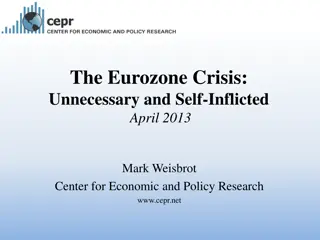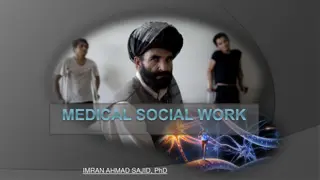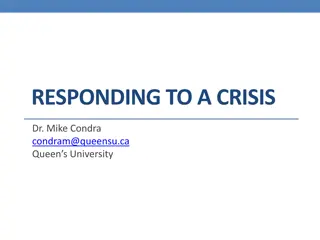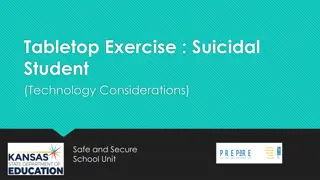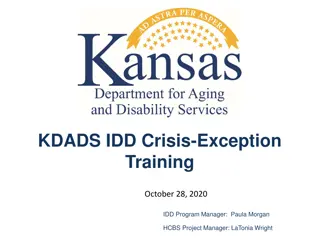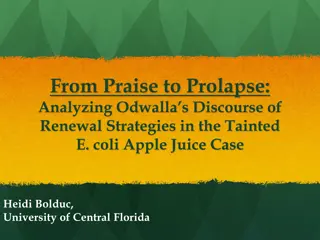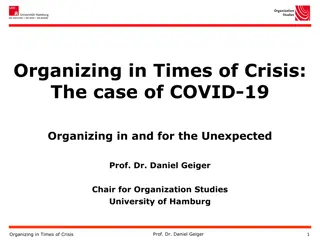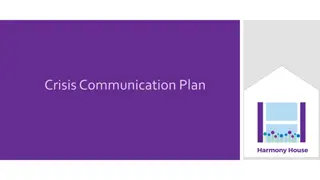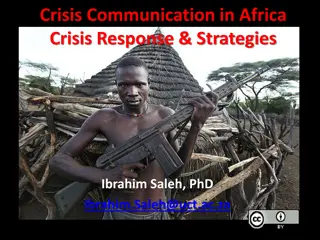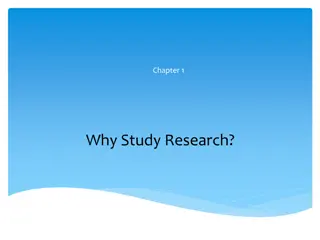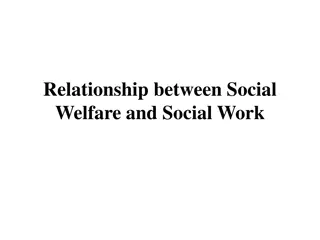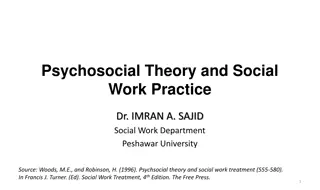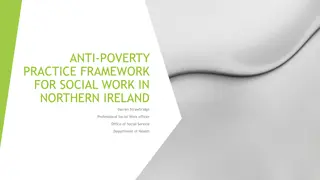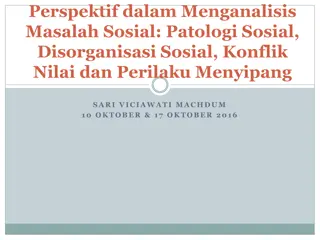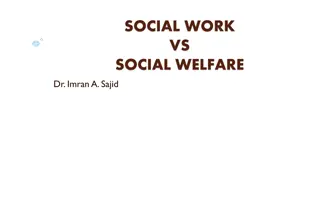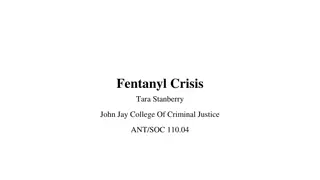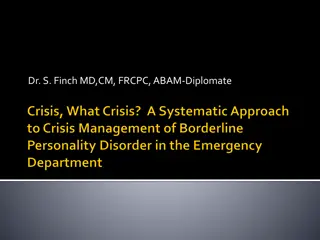Understanding Crisis Theory in Social Work Practice
Crisis is defined as an acute emotional upset that challenges an individual's coping abilities, resulting in distress and disorganization. This temporary state can be triggered by various personal, social, or cultural factors, leading to difficulty in problem-solving and a potential for positive or negative outcomes. Social work practice aims to support individuals, families, organizations, and communities during times of crisis to enhance their resilience and recovery.
Download Presentation

Please find below an Image/Link to download the presentation.
The content on the website is provided AS IS for your information and personal use only. It may not be sold, licensed, or shared on other websites without obtaining consent from the author. Download presentation by click this link. If you encounter any issues during the download, it is possible that the publisher has removed the file from their server.
E N D
Presentation Transcript
CRISIS THEORY and SOCIAL WORK PRACTICE by Muhammad Ghaffar MPhil /PhD Deptt: of Social Work, University of Peshawar
What is crisis ? The English word is derived from the Greek word krinein , meaning to decide. Chinese term for crisis... Weiji Weiji Is composed of two characters: one signifies .. . .the other Opportunity + Danger 2
dangerous or worrying time: a situation or period in which things are very uncertain, difficult, or painful, especially a time when action must be taken to avoid complete disaster or breakdown critical moment: a time when something very important for the future happens or is decided 3
DEFINITION A Crisis is An acute emotional upset in an individual s usual steady state, accompanied by a perceived breakdown in his or her usual coping abilities. It is manifested by physical, psychological, cognitive and relational distress & symptoms. It can be experienced by an individual independent of others, or by groups of individual within families, organizations, and communities. organization Community individual family 4
an acute emotional upset arising from situation, development, or socio-cultural sources and resulting in a temporary inability to cope by means of one s usual problem- solving devices crisis is a perception or experiencing of an event or situation as an intolerable difficulty that exceeds the person s current resources and coping mechanisms. 5
Generally Accepted Definition A temporary state of upset and disorganization, inability to cope with a particular situation using customary methods of problem solving, potential for a radically positive or negative outcome. 6
strain felt by somebody: mental, emotional, or physical strain caused, e.g. by anxiety or overwork. It may cause such symptoms as raised blood pressure or depression. 7
Whats happen in crisis A person is confronted with an overwhelming threat & cannot cope. This creates a crisis which can last 4-6 weeks. The person will either adapt at this point & develop new coping skills OR decompensate (not adapt) to a lower level of functioning. 9
What is a crisis for one person may not be a crisis for another person. Crises may range from a minor situations, such as not being prepared for class, to major life changes, such as death or divorce. Crisis is environmental based. What is now a crisis may not have been a crisis before or would not be a crisis in a different setting. How a person handles a crisis depends on: Their previous problem-solving experience (experience with coping & available coping mechanisms) The way they view the problem (how they perceive the event) And the amount of help (people who can be supportive to the person) OR hindrance from significant others 11
Risk and protective Factors Risk factors: Severity of exposure poor socio-economic condition Previous psychiatric symptoms Child abused and previous multiple Events Protective factors Personal strength Family and community characteristics Close bounds Caring educational and community programs 12
BASIC ASSUMPTIONS Acute situational distress is a normative life experience, an upset in a usually steady emotional, cognitive and physical state that is not pathological, that can happen to anyone, and that indeed, is likely to happen to most people at some time in their lives. Specific life events will be universally devastating. Past experiences (strengths & deficits) with crisis are generalized to the current crisis. During a state of disequilibrium, people will automatically strive to regain homeostasis or balance within their lives. The duration of crisis is usually limited depending on precipitating events, response patterns, and resources. Affective, cognitive, and behavioral tasks must be mastered in order to resolve the crisis regardless of the stressor. 18
A period of disequilibrium can result in greater vulnerability to further deterioration While struggling to regain emotional equilibrium, the individual is in an intense, time-limited state of psychological (in some case physiological) vulnerability. During this heightened state of vulnerability, the person is particularly amenable to psychological intervention. Crisis affords an opportunity for growth and development as well as for negative outcome. 19
Phases of crisis development Caplan outlined escalation of crisis: 1. 1. Phase 1 Phase 1: Initial rise in tension as well as that persons usual methods of coping to maintain homeostasis 2. 2. Phase 2 Phase 2: Lack of success leads to rise in tension as well as a sense of ineffectiveness 3. 3. Phase 3 Phase 3: Further rise in tension and the mobilization of internal and external resources using experimenting with new methods. Active resignation on unattainable goals & new levels of awareness 4. 4. Phase 4 Phase 4: Problem continues and does not subside with usual coping skills Breaking point where major disorganization with drastic results occurs. 20
Types of crisis Existential Developmental Beliefs & Values Situational Environmental 21
1. Existential crises Refers to the conflicts and anxious feelings experienced when facing the significant human issues of identity, purpose, responsibility, freedom and commitment. Aka existential dread, are moments individuals question question whether their lives have meaning, purpose, or value, and are negatively impacted by the contemplation moments when 22
2. Situational Crisis Refers to Unanticipated or sudden events arising from an external source that threaten the individual s integrity Examples: Job Loss, Death Of Loved One Abortion Job Change Financial Change Divorce Severe Illness 23
3. Developmental or maturational crisis Erikson found that there were specific times in normal development when anxiety or stress increases & could precipitate a maturational crisis Examples being born, mastering control of body functions, starting school, experiencing puberty, leaving home, getting married, becoming a parent, losing physical youthfulness & entering retirement Why are these times considered a crisis for some & not for other? It is thought that some people are unable to make the role changes necessary for the new maturational level. 24
Cont A good example might be the birth of a first child One couple is able to adapt & make the role change while another couple cannot readily adapt to the new role of being parents. There are three reasons why people may not be able to prevent a maturational crisis. They can t see themselves in the new role. They lack the interpersonal resources to make the role change (i.e. they are not flexible enough to change). Other people may refuse to recognize the role change. 25
4. Environmental crisis An unplanned, accidental event that is not part of everyday life. May be a natural disaster flood, fire or earthquake National disaster war, riot Crime of violence rape, murder, spousal or child abuse 26
CRISIS INTERVENTION Goals Relief of symptoms Restoration of pre-crisis level of functioning Understanding precipitating events and their contributions to disequilibrium Remedial measures to address results of crisis and prevent future crisis. 27
PHASES OF CRISIS INTERVENTION 1. Beginning Phase Establish contact Distinguish between a active crisis and or anticipatory crisis Assess Precipitating Factors Actual Crisis Event (What happened) Client s Subjective Response Historic and Current Coping Skills, Resources, and Strengths Client s Functional Skills & Abilities Triage the Most Pressing Concerns Contract with the Client Specific Goals & Interventions 28
Phases of Crisis Intervention 2. Middle Phase Initially the social worker takes an active role in implementing the goals and objective contracted; however as homeostasis is restored to the client the social worker becomes more passive. Carry out contracted goals, objectives, and tasks Help client develop resources, systems, and supports to address the residual issues of the crisis and develop preventive, maintenance strategies 29
Phases of Crisis Intervention 3. End Phase Termination Review progress of the case with the client including key themes and tasks accomplished Review current resources, supports, and systems developed to address the crisis Review preventative and maintenance devices developed Discuss future oriented, hope focused this too shall pass plans 30
Principals of Crisis Intervention Kathleen Ell 1. Aid is provided as quickly as possible, often through outreach programs 2. Intervention is a time limited and brief 3. The practitioner role is active 31
4. Symptom reduction is a primary goal 5. Practical information and tangible support is provided 6. Social support is mobilized 7. Expression of feelings, symptoms and worries are encouraged 8. Effective coping is supported to restore a sense of competency as early as possible 9. Cognitive issues about reality resting and confronting the experience are addressed 32
Principal Applications of Crisis Theory in Social Work Practice Currently social worker in 1. Child Welfare system, 2. schools, 3. rape treatment centre, 4. crisis response teams, 5. community mental health programs, 6. suicide prevention centers, 7. family services agencies and 8. medical care programs are expending the use of crisis theory and crisis interventions. 33
THANKS 34



